Spatiotemporal Patterns and Driving Factors of Green and Low-Carbon Urbanization in the Yangtze River Delta Region, China
Abstract
:1. Introduction
2. Materials and Methods
2.1. Study Area
2.2. Methods and Models
2.2.1. Evaluation Framework of GLCU
2.2.2. Coordination Relationship Analysis
2.2.3. Driving Factor Analysis
2.3. Data Source
3. Results and Discussion
3.1. Coordination between Urbanization and LCD
3.2. Driving Factors of GLCU
4. Conclusions and Policy Implications
4.1. Conclusions
4.2. Policy Implications
4.3. Limitations and Future Research Directions
Author Contributions
Funding
Institutional Review Board Statement
Informed Consent Statement
Data Availability Statement
Conflicts of Interest
References
- Chen, W.; Zhou, T.; Liang, J. Urbanization, Ecosystem Services, and Their Interactive Coercive Relationship in Hunan Province, China. Environ. Sci. Pollut. Res. 2023, 30, 3416–3431. [Google Scholar] [CrossRef]
- Zhou, Z.; Cao, L.; Zhao, K.; Li, D.; Ding, C. Spatio-Temporal Effects of Multi-Dimensional Urbanization on Carbon Emission Efficiency: Analysis Based on Panel Data of 283 Cities in China. Int. J. Environ. Res. Public Health 2021, 18, 12712. [Google Scholar] [CrossRef]
- García-Nieto, A.P.; Geijzendorffer, I.R.; Baró, F.; Roche, P.K.; Bondeau, A.; Cramer, W. Impacts of Urbanization around Mediterranean Cities: Changes in Ecosystem Service Supply. Ecol. Indic. 2018, 91, 589–606. [Google Scholar] [CrossRef]
- Ren, W.; Xue, B.; Xie, X.; Zhao, B.; Li, J.; Han, B. Urban Comprehensive Carrying Capacity and Urbanization in Northeast China. Sustainability 2023, 15, 13649. [Google Scholar] [CrossRef]
- Wang, S.; Shi, C.; Fang, C.; Feng, K. Examining the Spatial Variations of Determinants of Energy-Related CO2 Emissions in China at the City Level Using Geographically Weighted Regression Model. Appl. Energy 2019, 235, 95–105. [Google Scholar] [CrossRef]
- Dong, F.; Yu, B.; Hadachin, T.; Dai, Y.; Wang, Y.; Zhang, S.; Long, R. Drivers of Carbon Emission Intensity Change in China. Resour. Conserv. Recycl. 2018, 129, 187–201. [Google Scholar] [CrossRef]
- Song, Q.; Qin, M.; Wang, R.; Qi, Y. How Does the Nested Structure Affect Policy Innovation?: Empirical Research on China’s Low Carbon Pilot Cities. Energy Policy 2020, 144, 111695. [Google Scholar] [CrossRef]
- Sun, W.; Huang, C. How Does Urbanization Affect Carbon Emission Efficiency? Evidence from China. J. Clean. Prod. 2020, 272, 122828. [Google Scholar] [CrossRef]
- Poumanyvong, P.; Kaneko, S. Does Urbanization Lead to Less Energy Use and Lower CO2 Emissions? A Cross-Country Analysis. Ecol. Econ. 2010, 70, 434–444. [Google Scholar] [CrossRef]
- Xu, S.-C.; He, Z.-X.; Long, R.-Y.; Chen, H. Factors That Influence Carbon Emissions Due to Energy Consumption Based on Different Stages and Sectors in China. J. Clean. Prod. 2016, 115, 139–148. [Google Scholar] [CrossRef]
- Wang, Y.; Li, X.; Kang, Y.; Chen, W.; Zhao, M.; Li, W. Analyzing the Impact of Urbanization Quality on CO2 Emissions: What Can Geographically Weighted Regression Tell Us? Renew. Sustain. Energy Rev. 2019, 104, 127–136. [Google Scholar] [CrossRef]
- Khan, K.; Su, C.-W. Urbanization and Carbon Emissions: A Panel Threshold Analysis. Environ. Sci. Pollut. Res. 2021, 28, 26073–26081. [Google Scholar] [CrossRef]
- Li, J.; Huang, X.; Kwan, M.-P.; Yang, H.; Chuai, X. The Effect of Urbanization on Carbon Dioxide Emissions Efficiency in the Yangtze River Delta, China. J. Clean. Prod. 2018, 188, 38–48. [Google Scholar] [CrossRef]
- Shen, L.; Wu, Y.; Lou, Y.; Zeng, D.; Shuai, C.; Song, X. What Drives the Carbon Emission in the Chinese Cities?—A Case of Pilot Low Carbon City of Beijing. J. Clean. Prod. 2018, 174, 343–354. [Google Scholar] [CrossRef]
- Liu, N.; Liu, C.; Xia, Y.; Da, B. Examining the Coordination between Urbanization and Eco-Environment Using Coupling and Spatial Analyses: A Case Study in China. Ecol. Indic. 2018, 93, 1163–1175. [Google Scholar] [CrossRef]
- Zhang, K.; Liu, T.; Feng, R.; Zhang, Z.; Liu, K. Coupling Coordination Relationship and Driving Mechanism between Urbanization and Ecosystem Service Value in Large Regions: A Case Study of Urban Agglomeration in Yellow River Basin, China. Int. J. Environ. Res. Public Health 2021, 18, 7836. [Google Scholar] [CrossRef]
- Zhang, Y.; Dai, Y.; Chen, Y.; Ke, X. Coupling Coordination Development of New-Type Urbanization and Cultivated Land Low-Carbon Utilization in the Yangtze River Delta, China. Land 2022, 11, 919. [Google Scholar] [CrossRef]
- Liu, X.; Guo, P.; Yue, X.; Zhong, S.; Cao, X. Urban Transition in China: Examining the Coordination between Urbanization and the Eco-Environment Using a Multi-Model Evaluation Method. Ecol. Indic. 2021, 130, 108056. [Google Scholar] [CrossRef]
- Tian, Y.; Zhou, D.; Jiang, G. Conflict or Coordination? Multiscale Assessment of the Spatio-Temporal Coupling Relationship between Urbanization and Ecosystem Services: The Case of the Jingjinji Region, China. Ecol. Indic. 2020, 117, 106543. [Google Scholar] [CrossRef]
- Song, Q.; Zhou, N.; Liu, T.; Siehr, S.A.; Qi, Y. Investigation of a “Coupling Model” of Coordination between Low-Carbon Development and Urbanization in China. Energy Policy 2018, 121, 346–354. [Google Scholar] [CrossRef]
- Li, D.; Cao, L.; Zhou, Z.; Zhao, K.; Du, Z.; Han, K. Coupling Coordination Degree and Driving Factors of New-Type Urbanization and Low-Carbon Development in the Yangtze River Delta: Based on Nighttime Light Data. Environ. Sci. Pollut. Res. 2022, 29, 81636–81657. [Google Scholar] [CrossRef] [PubMed]
- Guo, X.; Fang, C.; Mu, X.; Chen, D. Coupling and Coordination Analysis of Urbanization and Ecosystem Service Value in Beijing-Tianjin-Hebei Urban Agglomeration. Ecol. Indic. 2022, 137, 108782. [Google Scholar] [CrossRef]
- Qin, H.; Huang, Q.; Zhang, Z.; Lu, Y.; Li, M.; Xu, L.; Chen, Z. Carbon Dioxide Emission Driving Factors Analysis and Policy Implications of Chinese Cities: Combining Geographically Weighted Regression with Two-Step Cluster. Sci. Total Environ. 2019, 684, 413–424. [Google Scholar] [CrossRef] [PubMed]
- Xia, C.; Zheng, H.; Meng, J.; Li, S.; Du, P.; Shan, Y. The Evolution of Carbon Footprint in the Yangtze River Delta City Cluster during Economic Transition 2012–2015. Resour. Conserv. Recycl. 2022, 181, 106266. [Google Scholar] [CrossRef]
- Yu, X.; Wu, Z.; Zheng, H.; Li, M.; Tan, T. How Urban Agglomeration Improve the Emission efficiency? A Spatial Econometric Analysis of the Yangtze River Delta Urban Agglomeration in China. J. Environ. Manag. 2020, 260, 110061. [Google Scholar] [CrossRef] [PubMed]
- Hou, Y.; Zhang, K.; Zhu, Y.; Liu, W. Spatial and Temporal Differentiation and Influencing Factors of Environmental Governance Performance in the Yangtze River Delta, China. Sci. Total Environ. 2021, 801, 149699. [Google Scholar] [CrossRef] [PubMed]
- Ni, R.; Wang, F.; Yu, J. Spatiotemporal Changes in Sustainable Development and Its Driving Force in the Yangtze River Delta Region, China. J. Clean. Prod. 2022, 379, 134751. [Google Scholar] [CrossRef]
- NBS. China Statistical Yearbook; China Statistics Press: Beijing, China, 2021. [Google Scholar]
- Zhou, C.; Wang, S.; Wang, J. Examining the Influences of Urbanization on Carbon Dioxide Emissions in the Yangtze River Delta, China: Kuznets Curve Relationship. Sci. Total Environ. 2019, 675, 472–482. [Google Scholar] [CrossRef] [PubMed]
- Qiu, S.; Wang, Z.; Liu, S. The Policy Outcomes of Low-Carbon City Construction on Urban Green Development: Evidence from a Quasi-Natural Experiment Conducted in China. Sustain. Cities Soc. 2021, 66, 102699. [Google Scholar] [CrossRef]
- Lv, T.; Hu, H.; Zhang, X.; Xie, H.; Wang, L.; Fu, S. Spatial Spillover Effects of Urbanization on Carbon Emissions in the Yangtze River Delta Urban Agglomeration, China. Environ. Sci. Pollut. Res. 2022, 29, 33920–33934. [Google Scholar] [CrossRef]
- Cheng, J.; Yi, J.; Dai, S.; Xiong, Y. Can Low-Carbon City Construction Facilitate Green Growth? Evidence from China’s Pilot Low-Carbon City Initiative. J. Clean. Prod. 2019, 231, 1158–1170. [Google Scholar] [CrossRef]
- Dong, L.; Shang, J.; Ali, R.; Rehman, R.U. The Coupling Coordinated Relationship Between New-Type Urbanization, Eco-Environment and Its Driving Mechanism: A Case of Guanzhong, China. Front. Environ. Sci. 2021, 9, 638891. [Google Scholar] [CrossRef]
- He, J.; Wang, S.; Liu, Y.; Ma, H.; Liu, Q. Examining the Relationship between Urbanization and the Eco-Environment Using a Coupling Analysis: Case Study of Shanghai, China. Ecol. Indic. 2017, 77, 185–193. [Google Scholar] [CrossRef]
- Wang, Z.; Liang, L.; Sun, Z.; Wang, X. Spatiotemporal Differentiation and the Factors Influencing Urbanization and Ecological Environment Synergistic Effects within the Beijing-Tianjin-Hebei Urban Agglomeration. J. Environ. Manag. 2019, 243, 227–239. [Google Scholar] [CrossRef]
- Wang, Y.; Fang, X.; Yin, S.; Chen, W. Low-Carbon Development Quality of Cities in China: Evaluation and Obstacle Analysis. Sustain. Cities Soc. 2021, 64, 102553. [Google Scholar] [CrossRef]
- Yu, Y.; Tong, Y.; Tang, W.; Yuan, Y.; Chen, Y. Identifying Spatiotemporal Interactions between Urbanization and Eco-Environment in the Urban Agglomeration in the Middle Reaches of the Yangtze River, China. Sustainability 2018, 10, 290. [Google Scholar] [CrossRef]
- Long, R.; Li, H.; Wu, M.; Li, W. Dynamic Evaluation of the Green Development Level of China’s Coal-Resource-Based Cities Using the TOPSIS Method. Resour. Policy 2021, 74, 102415. [Google Scholar] [CrossRef]
- Lu, Z.; Shao, C.; Wang, F.; Dong, R. Evaluation of Green and Low-Carbon Development Level of Chinese Provinces Based on Sustainable Development Goals. Sustainability 2023, 15, 15449. [Google Scholar] [CrossRef]
- Du, X.; Shen, L.; Ren, Y.; Meng, C. A Dimensional Perspective-Based Analysis on the Practice of Low Carbon City in China. Environ. Impact Assess. Rev. 2022, 95, 106768. [Google Scholar] [CrossRef]
- Cui, X.; Fang, C.; Liu, H.; Liu, X. Assessing Sustainability of Urbanization by a Coordinated Development Index for an Urbanization-Resources-Environment Complex System: A Case Study of Jing-Jin-Ji Region, China. Ecol. Indic. 2019, 96, 383–391. [Google Scholar] [CrossRef]
- Li, Y.; Li, Y.; Zhou, Y.; Shi, Y.; Zhu, X. Investigation of a Coupling Model of Coordination between Urbanization and the Environment. J. Environ. Manag. 2012, 98, 127–133. [Google Scholar] [CrossRef]
- Liu, W.; Zhan, J.; Zhao, F.; Wei, X.; Zhang, F. Exploring the Coupling Relationship between Urbanization and Energy Eco-Efficiency: A Case Study of 281 Prefecture-Level Cities in China. Sustain. Cities Soc. 2021, 64, 102563. [Google Scholar] [CrossRef]
- Duan, Z.; Kim, S. Characteristics and Variations in Korea through the Lens of Net-Zero Carbon Transformation in Cities. Sustainability 2023, 15, 13748. [Google Scholar] [CrossRef]
- Zhu, S.; Huang, J.; Zhao, Y. Coupling Coordination Analysis of Ecosystem Services and Urban Development of Resource-Based Cities: A Case Study of Tangshan City. Ecol. Indic. 2022, 136, 108706. [Google Scholar] [CrossRef]
- Li, W.; Wang, Y.; Xie, S.; Cheng, X. Coupling Coordination Analysis and Spatiotemporal Heterogeneity between Urbanization and Ecosystem Health in Chongqing Municipality, China. Sci. Total Environ. 2021, 791, 148311. [Google Scholar] [CrossRef] [PubMed]
- Luo, Q.; Zhou, J.; Zhang, Y.; Yu, B.; Zhu, Z. What Is the Spatiotemporal Relationship between Urbanization and Ecosystem Services? A Case from 110 Cities in the Yangtze River Economic Belt, China. J. Environ. Manag. 2022, 321, 115709. [Google Scholar] [CrossRef] [PubMed]
- Wang, L.; Chen, L.; Li, Y. Digital Economy and Urban Low-Carbon Sustainable Development: The Role of Innovation Factor Mobility in China. Environ. Sci. Pollut. Res. 2022, 29, 48539–48557. [Google Scholar] [CrossRef] [PubMed]
- Hartigan, J.A.; Wong, M.A. Algorithm AS 136: A K-Means Clustering Algorithm. J. R. Stat. Soc. 1979, 28, 100–108. [Google Scholar] [CrossRef]
- Wu, Y.; Wu, Y.; Li, C.; Gao, B.; Zheng, K.; Wang, M.; Deng, Y.; Fan, X. Spatial Relationships and Impact Effects between Urbanization and Ecosystem Health in Urban Agglomerations along the Belt and Road: A Case Study of the Guangdong-Hong Kong-Macao Greater Bay Area. Int. J. Environ. Res. Public Health 2022, 19, 16053. [Google Scholar] [CrossRef]
- Xu, B.; Xu, L.; Xu, R.; Luo, L. Geographical Analysis of CO2 Emissions in China’s Manufacturing Industry: A Geographically Weighted Regression Model. J. Clean. Prod. 2017, 166, 628–640. [Google Scholar] [CrossRef]
- Hu, W.; Liu, J. The Coupling and Coordination of Urban Modernization and Low-Carbon Development. Sustainability 2023, 15, 14335. [Google Scholar] [CrossRef]
- Huang, B.; Wu, B.; Barry, M. Geographically and Temporally Weighted Regression for Modeling Spatio-Temporal Variation in House Prices. Int. J. Geogr. Inf. Sci. 2010, 24, 383–401. [Google Scholar] [CrossRef]
- Cai, B.; Liang, S.; Zhou, J.; Wang, J.; Cao, L.; Qu, S.; Xu, M.; Yang, Z. China High Resolution Emission Database (CHRED) with Point Emission Sources, Gridded Emission Data, and Supplementary Socioeconomic Data. Resour. Conserv. Recycl. 2018, 129, 232–239. [Google Scholar] [CrossRef]
- Cai, B.; Cui, C.; Zhang, D.; Cao, L.; Wu, P.; Pang, L.; Zhang, J.; Dai, C. China City-Level Greenhouse Gas Emissions Inventory in 2015 and Uncertainty Analysis. Appl. Energy 2019, 253, 113579. [Google Scholar] [CrossRef]
- Liddle, B. Impact of Population, Age Structure, and Urbanization on Carbon Emissions/Energy Consumption: Evidence from Macro-Level, Cross-Country Analyses. Popul. Environ. 2014, 35, 286–304. [Google Scholar] [CrossRef]
- Cai, B.; Guo, H.; Cao, L.; Guan, D.; Bai, H. Local Strategies for China’s Carbon Mitigation: An Investigation of Chinese City-Level CO2 Emissions. J. Clean. Prod. 2018, 178, 890–902. [Google Scholar] [CrossRef]
- Liu, Y.; Jiang, Y.; Liu, H.; Li, B.; Yuan, J. Driving Factors of Carbon Emissions in China’s Municipalities: A LMDI Approach. Environ. Sci. Pollut. Res. 2022, 29, 21789–21802. [Google Scholar] [CrossRef]
- Wang, F.; Fan, W.; Liu, J.; Wang, G.; Chai, W. The Effect of Urbanization and Spatial Agglomeration on Carbon Emissions in Urban Agglomeration. Environ. Sci. Pollut. Res. 2020, 27, 24329–24341. [Google Scholar] [CrossRef] [PubMed]
- Wang, Z.; Cui, C.; Peng, S. How Do Urbanization and Consumption Patterns Affect Carbon Emissions in China? A Decomposition Analysis. J. Clean. Prod. 2019, 211, 1201–1208. [Google Scholar] [CrossRef]
- Wang, C.; Zhan, J.; Chu, X.; Liu, W.; Zhang, F. Variation in Ecosystem Services with Rapid Urbanization: A Study of Carbon Sequestration in the Beijing–Tianjin–Hebei Region, China. Phys. Chem. Earth 2019, 110, 195–202. [Google Scholar] [CrossRef]
- Ding, T.; Chen, J.; Fang, Z.; Chen, J. Assessment of Coordinative Relationship between Comprehensive Ecosystem Service and Urbanization: A Case Study of Yangtze River Delta Urban Agglomerations, China. Ecol. Indic. 2021, 133, 108454. [Google Scholar] [CrossRef]
- Shen, X.; Zheng, H.; Jiang, M.; Yu, X.; Xu, H.; Zhong, G. Multidimensional Impact of Urbanization Process on Regional Net CO2 Emissions: Taking the Yangtze River Economic Belt as an Example. Land 2022, 11, 1079. [Google Scholar] [CrossRef]
- Wang, J.; Zhao, M.; Zhong, W.; Li, J.; Zheng, C. Coupling Relationship of Urban Development and the Eco-Environment in Guanzhong Region, China. Sustainability 2022, 14, 2969. [Google Scholar] [CrossRef]
- Zhao, P.; Zhang, M. The Impact of Urbanisation on Energy Consumption: A 30-Year Review in China. Urban Clim. 2018, 24, 940–953. [Google Scholar] [CrossRef]
- Li, C.; Li, H.; Qin, X. Spatial Heterogeneity of Carbon Emissions and Its Influencing Factors in China: Evidence from 286 Prefecture-Level Cities. Int. J. Environ. Res. Public Health 2022, 19, 1226. [Google Scholar] [CrossRef]
- Du, H.; Chen, Z.; Mao, G.; Li, R.Y.M.; Chai, L. A Spatio-Temporal Analysis of Low Carbon Development in China’s 30 Provinces: A Perspective on the Maximum Flux Principle. Ecol. Indic. 2018, 90, 54–64. [Google Scholar] [CrossRef]
- Fang, Y.; Shan, Z. How to Promote a Smart City Effectively? An Evaluation Model and Efficiency Analysis of Smart Cities in China. Sustainability 2022, 14, 6512. [Google Scholar] [CrossRef]
- Zhao, X.; Burnett, J.W.; Fletcher, J.J. Spatial Analysis of China Province-Level CO2 Emission Intensity. Renew. Sustain. Energy Rev. 2014, 33, 1–10. [Google Scholar] [CrossRef]
- Gong, W.-F.; Fan, Z.-Y.; Wang, C.-H.; Wang, L.-P.; Li, W.-W. Spatial Spillover Effect of Carbon Emissions and Its Influencing Factors in the Yellow River Basin. Sustainability 2022, 14, 3608. [Google Scholar] [CrossRef]
- Wu, S.; Zhang, K. Influence of Urbanization and Foreign Direct Investment on Carbon Emission Efficiency: Evidence from Urban Clusters in the Yangtze River Economic Belt. Sustainability 2021, 13, 2722. [Google Scholar] [CrossRef]
- Wang, Y.; Duan, X.; Wang, L.; Zou, H. Spatial Temporal Patterns and Driving Factors of Industrial Pollution and Structures in the Yangtze River Economic Belt. Chemosphere 2022, 303, 134996. [Google Scholar] [CrossRef]
- Song, M.; Tao, W.; Shen, Z. Improving High-Quality Development with Environmental Regulation and Industrial Structure in China. J. Clean. Prod. 2022, 366, 132997. [Google Scholar] [CrossRef]
- Xu, J.; Li, Y.; Hu, F.; Wang, L.; Wang, K.; Ma, W.; Ruan, N.; Jiang, W. Spatio-Temporal Variation of Carbon Emission Intensity and Spatial Heterogeneity of Influencing Factors in the Yangtze River Delta. Atmosphere 2023, 14, 163. [Google Scholar] [CrossRef]
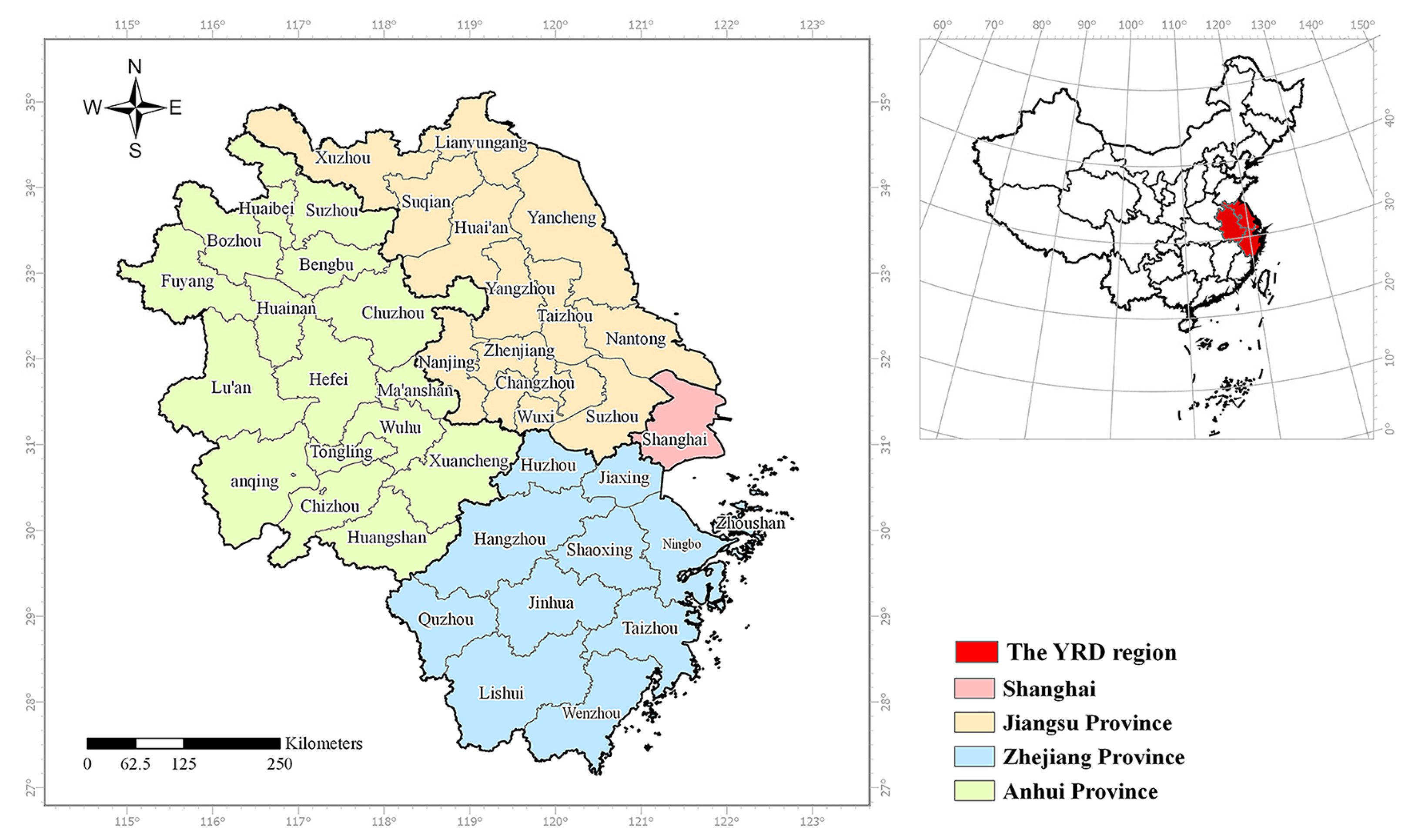
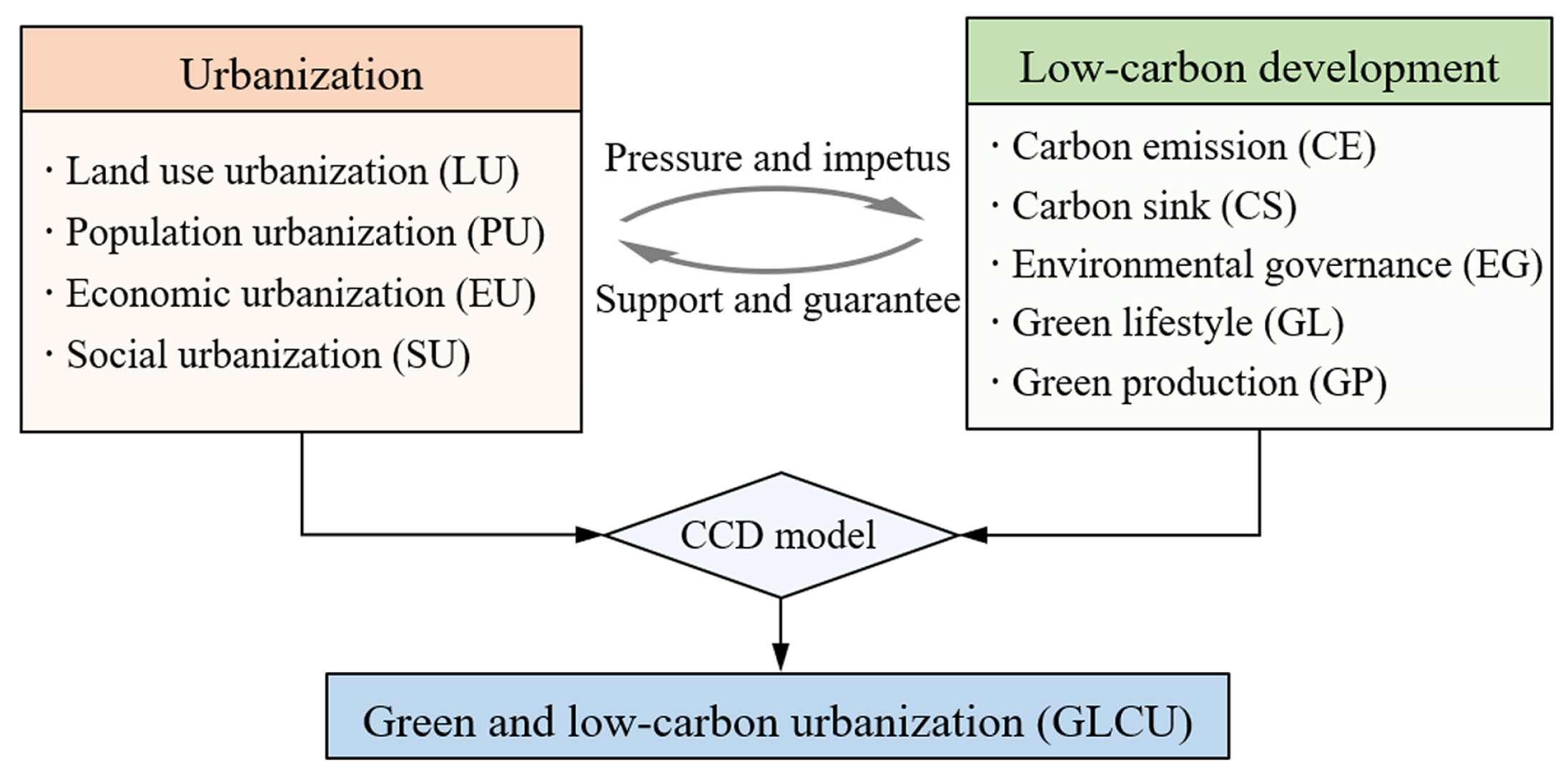

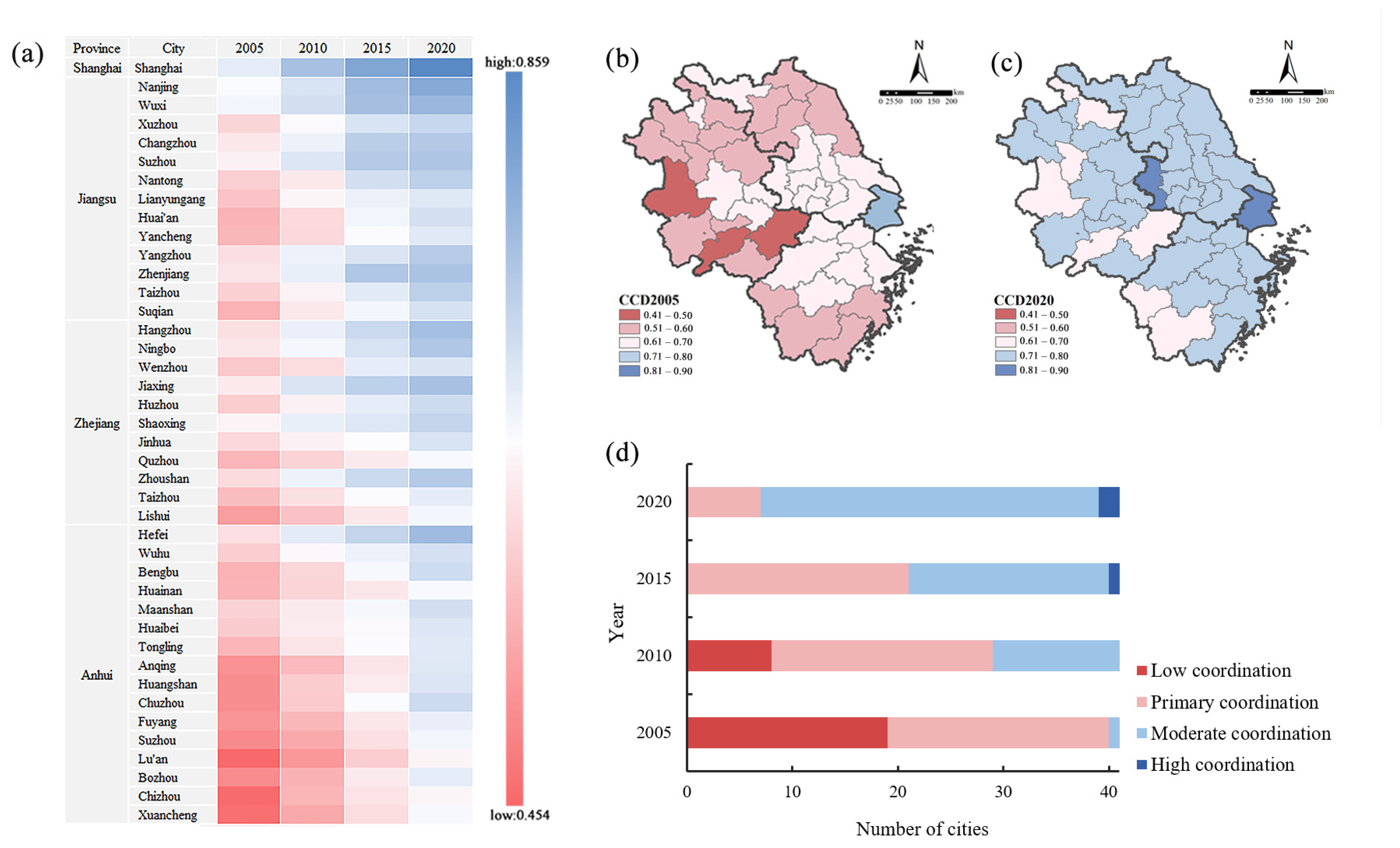

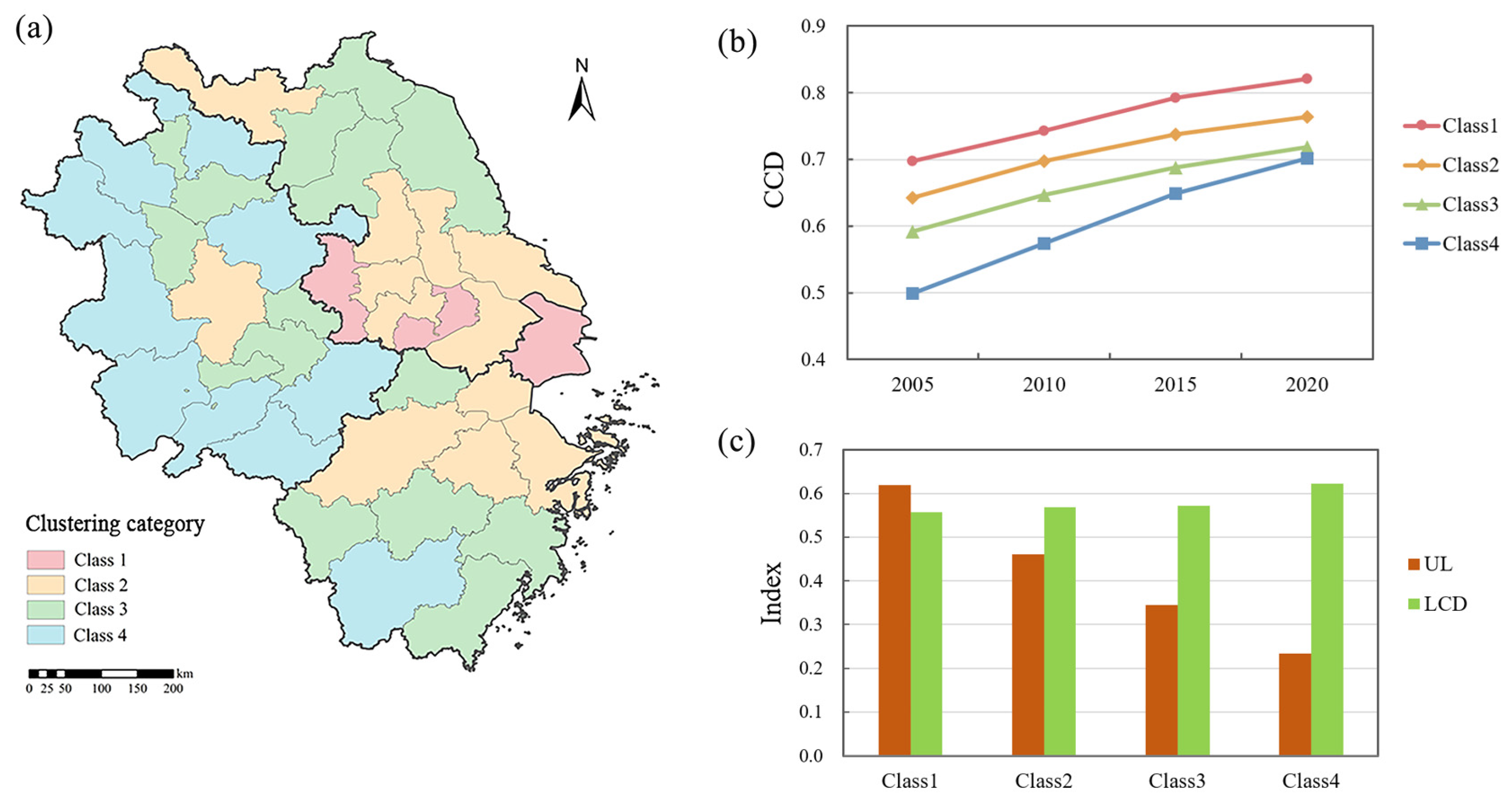
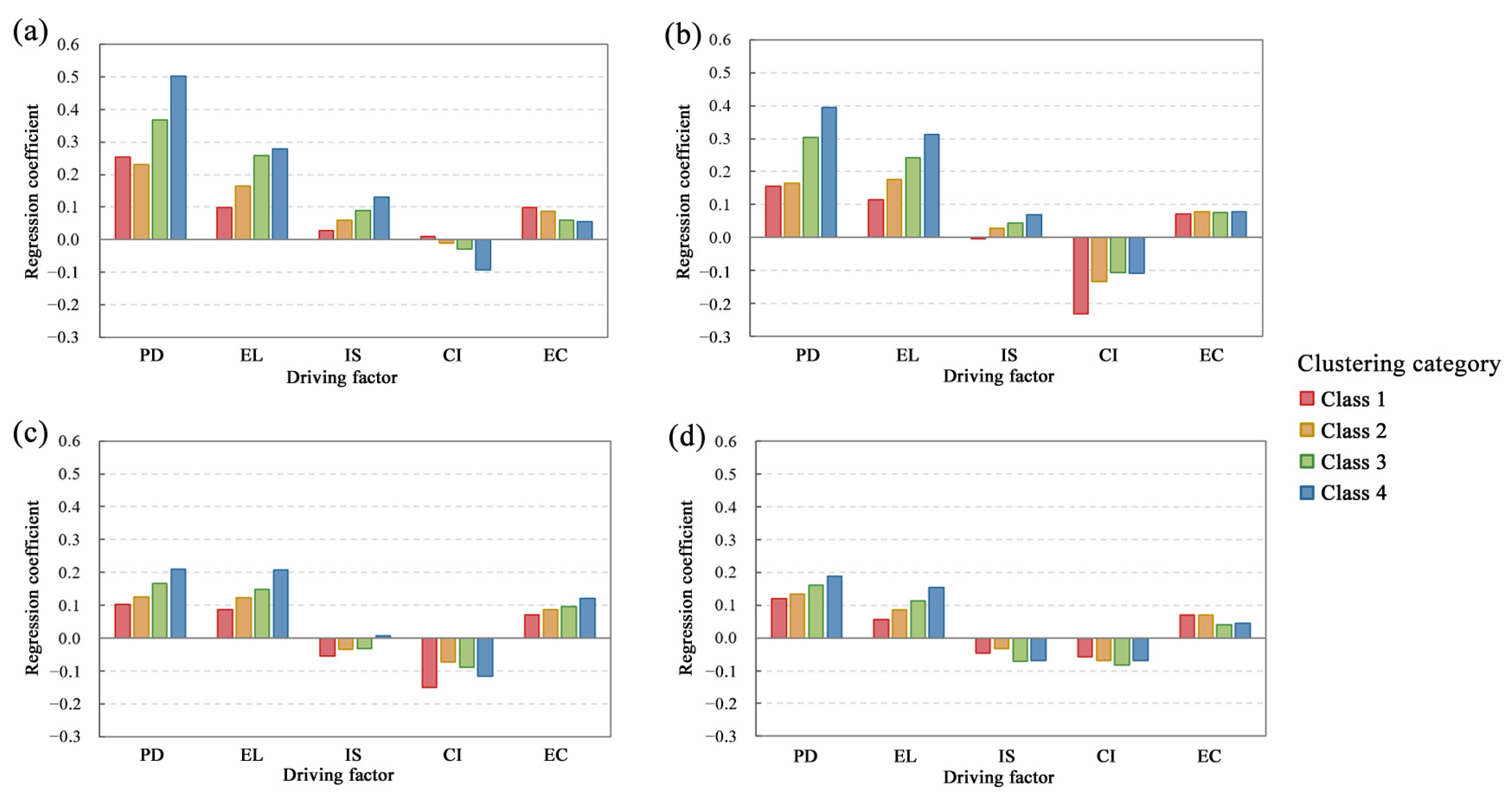
| System | Dimensions | Indicator | Indicator Property 1 | References | Weights |
|---|---|---|---|---|---|
| Urbanization | Land use urbanization (LU) | Built-up area per capita (m2) | + | [34] | 0.0840 |
| Road surface area per capita (m2) | + | [37] | 0.0567 | ||
| Proportion of construction land area (%) | + | [34] | 0.1143 | ||
| Population urbanization (PU) | Urbanization rate of permanent residents (%) | + | [18] | 0.0623 | |
| Proportion of non-agricultural employees (%) | + | [34] | 0.0508 | ||
| Population density (inhabitants/km2) | + | [34] | 0.1660 | ||
| Economic urbanization (EU) | GDP per capita (CNY) | + | [34] | 0.1253 | |
| Proportion of secondary and tertiary industries in the total GDP (%) | + | [34] | 0.0199 | ||
| Disposable income of urban residents per capita (CNY) | + | [35] | 0.1290 | ||
| Social urbanization (SU) | Number of beds in health institutions per 10,000 people (beds) | + | [35] | 0.0684 | |
| Number of public transport vehicles per 10,000 people (vehicles) | + | [34] | 0.1016 | ||
| Water coverage rate (%) | + | [38] | 0.0091 | ||
| Gas coverage rate (%) | + | [38] | 0.0127 | ||
| Low-carbon development (LCD) | Carbon emission (CE) | CO2 emissions per capita (ton) | − | [21] | 0.0450 |
| CO2 emission intensity (ton/10,000 CNY) | − | [21] | 0.0205 | ||
| Carbon sink (CS) | Green coverage rate of built-up area (%) | + | [37] | 0.0543 | |
| Public green area per capita (m2) | + | [34] | 0.1425 | ||
| Environmental governance (EG) | Sewage treatment rate (%) | + | [34] | 0.0519 | |
| Comprehensive utilization rate of general industrial solid waste (%) | + | [37] | 0.0534 | ||
| Green lifestyle (GL) | Domestic water consumption per capita (liter) | − | [39] | 0.0844 | |
| Domestic electricity consumption per capita (kwh) | − | [39] | 0.1400 | ||
| Domestic garbage production per capita (kg) | − | [18] | 0.0926 | ||
| Green production (GP) | The ratio of tertiary industry to secondary industry output value (%) | + | [21] | 0.2278 | |
| SO2 emissions per unit of industrial output value (ton/10,000 CNY) | − | [34] | 0.0232 | ||
| Electricity consumption per unit of industrial output value (kwh/10,000 CNY) | − | [40] | 0.0524 | ||
| Electricity consumption per unit of GDP (kwh/10,000 CNY) | − | [36] | 0.0119 |
| City Class | Urbanization Rate of Permanent Residents (%) | Population Density (Inhabitants/km2) | Per Capita GDP (104 CNY) | Proportion of Secondary Industries in the Total GDP (%) | Per GDP CO2 Emissions (ton/104 CNY) | Per GDP Electricity Consumption (kwh/104 CNY) |
|---|---|---|---|---|---|---|
| Class1 | 86.3 | 2316 | 16.0 | 36.1 | 0.8 | 483 |
| (84.8, 88.1) | (1512, 2767) | (15.7, 16.2) | (30.9, 40.8) | (0.7, 0.8) | (417, 521) | |
| Class2 | 74.7 | 899 | 12.4 | 43.8 | 0.9 | 618 |
| (70.8, 79.5) | (732, 960) | (11.3, 13.3) | (40.1, 47.1) | (0.7, 1.0) | (499, 684) | |
| Class3 | 64.6 | 558 | 7.6 | 42.6 | 1.7 | 728 |
| (61.8, 67.1) | (496, 625) | (6.6, 8.9) | (40.2, 44.5) | (0.7, 2.5) | (597, 901) | |
| Class4 | 53.5 | 347 | 5.4 | 39.8 | 1.1 | 660 |
| (44.9, 60.5) | (171, 479) | (3.8, 6.4) | (35.4, 43.9) | (0.7, 1.1) | (491, 753) |
Disclaimer/Publisher’s Note: The statements, opinions and data contained in all publications are solely those of the individual author(s) and contributor(s) and not of MDPI and/or the editor(s). MDPI and/or the editor(s) disclaim responsibility for any injury to people or property resulting from any ideas, methods, instructions or products referred to in the content. |
© 2024 by the authors. Licensee MDPI, Basel, Switzerland. This article is an open access article distributed under the terms and conditions of the Creative Commons Attribution (CC BY) license (https://creativecommons.org/licenses/by/4.0/).
Share and Cite
Huang, Y.; Kuai, C.; Wang, F. Spatiotemporal Patterns and Driving Factors of Green and Low-Carbon Urbanization in the Yangtze River Delta Region, China. Sustainability 2024, 16, 4006. https://doi.org/10.3390/su16104006
Huang Y, Kuai C, Wang F. Spatiotemporal Patterns and Driving Factors of Green and Low-Carbon Urbanization in the Yangtze River Delta Region, China. Sustainability. 2024; 16(10):4006. https://doi.org/10.3390/su16104006
Chicago/Turabian StyleHuang, Yingao, Chenjun Kuai, and Feier Wang. 2024. "Spatiotemporal Patterns and Driving Factors of Green and Low-Carbon Urbanization in the Yangtze River Delta Region, China" Sustainability 16, no. 10: 4006. https://doi.org/10.3390/su16104006




